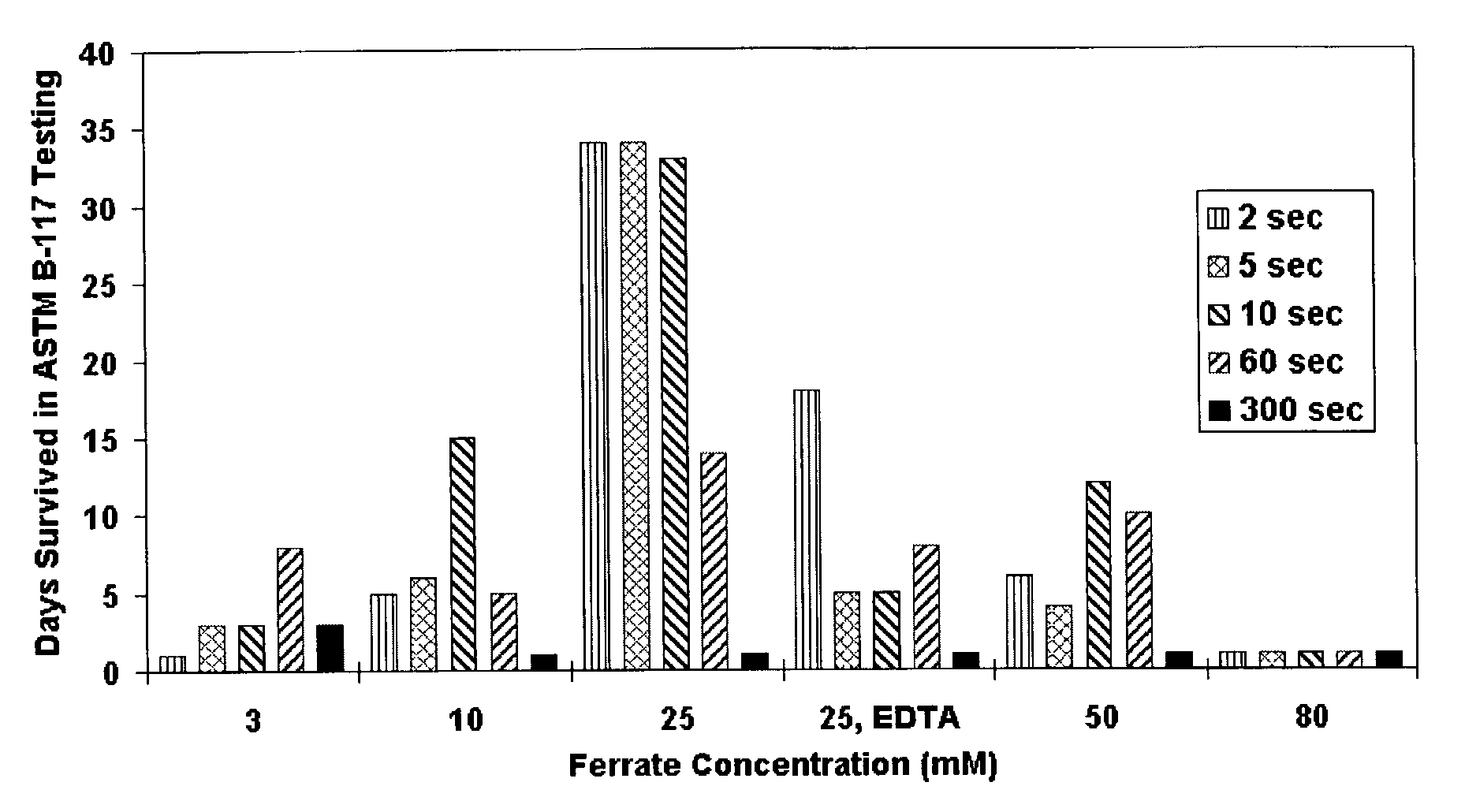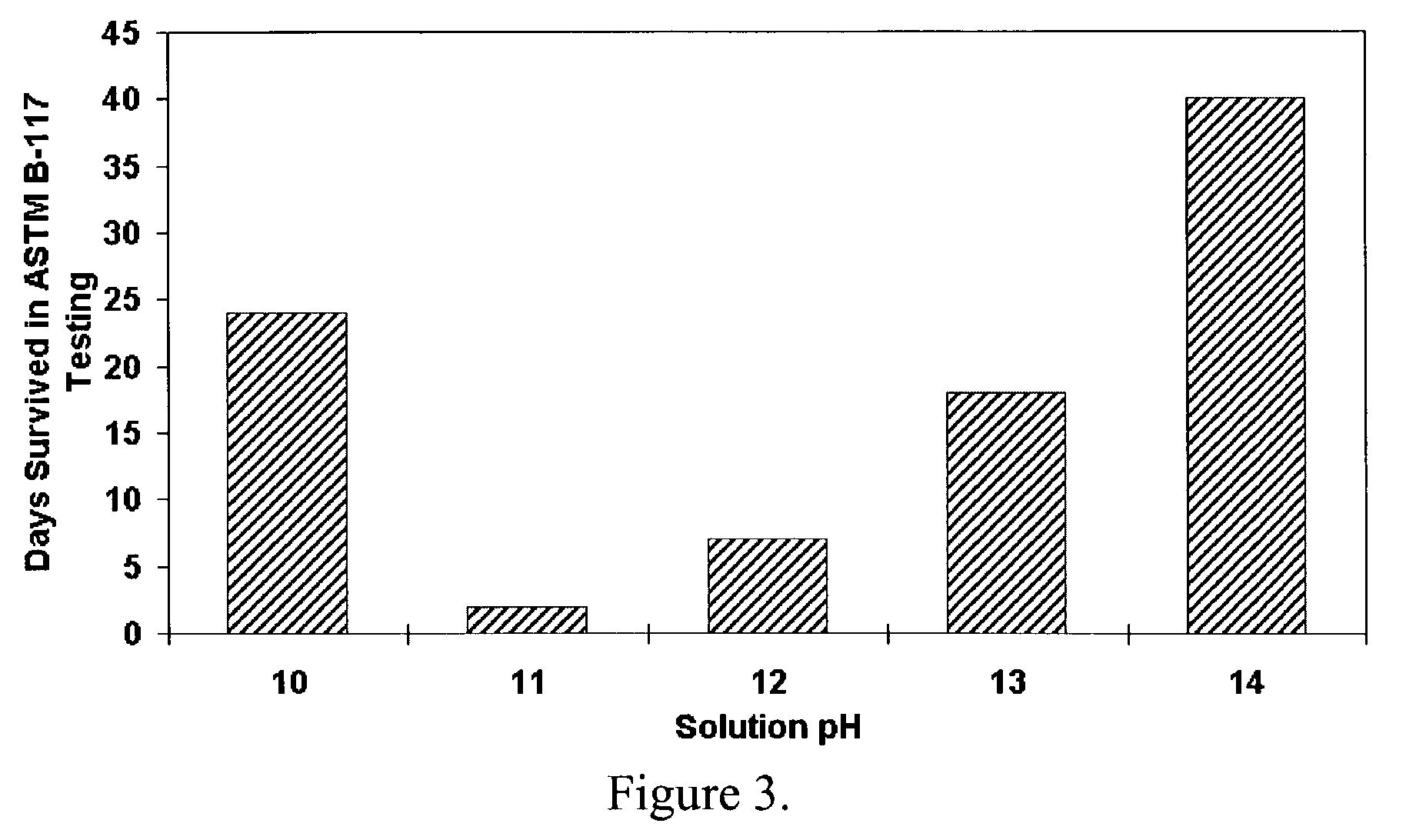Ferrate conversion coatings for metal substrates
a technology of metal substrates and conversion coatings, applied in the direction of solid-state diffusion coatings, coatings, metallic material coating processes, etc., can solve the problem of slow reaction rate between ferrate and substra
- Summary
- Abstract
- Description
- Claims
- Application Information
AI Technical Summary
Benefits of technology
Problems solved by technology
Method used
Image
Examples
example 1
Preparation of Aluminum or Aluminum Alloy Panels
[0043]Except where indicated, aluminum or aluminum alloy panels were used in the following examples. Prior to contacting the panels with a coating solution, the panels were prepared by sonication in acetone for 30 minutes. They were then cleaned with an alkaline cleaning solution (such as 4215 NCLT available from Elf Atochem—Turco Products Division, Westminster, Calif.) for 10 minutes at 50° C. to 60° C. The panels were then rinsed with deionized water and immersed in a deoxidizing solution of 15% LNC deoxidizer (Oakite Products, Inc., Berkeley Heights, N.J.) for 10 minutes at room temperature. Optionally, the cleaned panels could then be exposed to boiling water or anodization to form an oxide layer. The panels were then thoroughly rinsed with deionized water and allowed to dry.
example 2
Aluminum or Aluminum Alloy Panels Treated with Conversion Coating Solutions Containing only Ferrate(VI)
[0044]Aqueous solutions of ferrate(VI) having concentrations between 0.0166% (1 mM) to 1.66% (100 mM) ferrate(VI) were prepared. Aluminum panels, prepared as described in Example 1, were immersed in each of the solutions for a period between 1 second and 5 minutes at a temperature between 25° C. and 80° C. The panels were then rinsed thoroughly with deionized water, dried in air for 48 to 94 hours, and tested by salt fog spray according to the ASTM B-117 test method (samples were placed at 15° angle).
example 3
Aluminum or Aluminum Alloy Panels Treated with Conversion Coating Solutions Containing Ferrate(VI) in Combination with One or More Oxyanions or Salts
[0045]Aqueous solutions of ferrate(VI) having concentrations between 0.0166% (1 mM) and 1.66% (100 mM) ferrate(VI), with or without 0.5% sodium nitrate, 1.0% to 3.0% of one or more of potassium permanganate and potassium molybdate, and 0.5% to 1.0% of one or more of lithium chloride or lithium nitrate were prepared. The aluminum panels prepared as described in Example 1 were immersed in this conversion coating solution for between 1 second and 5 minutes at temperatures between 25° C. and 80° C. The panels were then rinsed thoroughly with deionized water, dried in air for 48 to 94 hours, and tested by salt fog spray according to ASTM B-117 test method (samples were placed at 15° angle).
PUM
| Property | Measurement | Unit |
|---|---|---|
| temperature | aaaaa | aaaaa |
| temperature | aaaaa | aaaaa |
| temperature | aaaaa | aaaaa |
Abstract
Description
Claims
Application Information
 Login to View More
Login to View More - R&D
- Intellectual Property
- Life Sciences
- Materials
- Tech Scout
- Unparalleled Data Quality
- Higher Quality Content
- 60% Fewer Hallucinations
Browse by: Latest US Patents, China's latest patents, Technical Efficacy Thesaurus, Application Domain, Technology Topic, Popular Technical Reports.
© 2025 PatSnap. All rights reserved.Legal|Privacy policy|Modern Slavery Act Transparency Statement|Sitemap|About US| Contact US: help@patsnap.com



